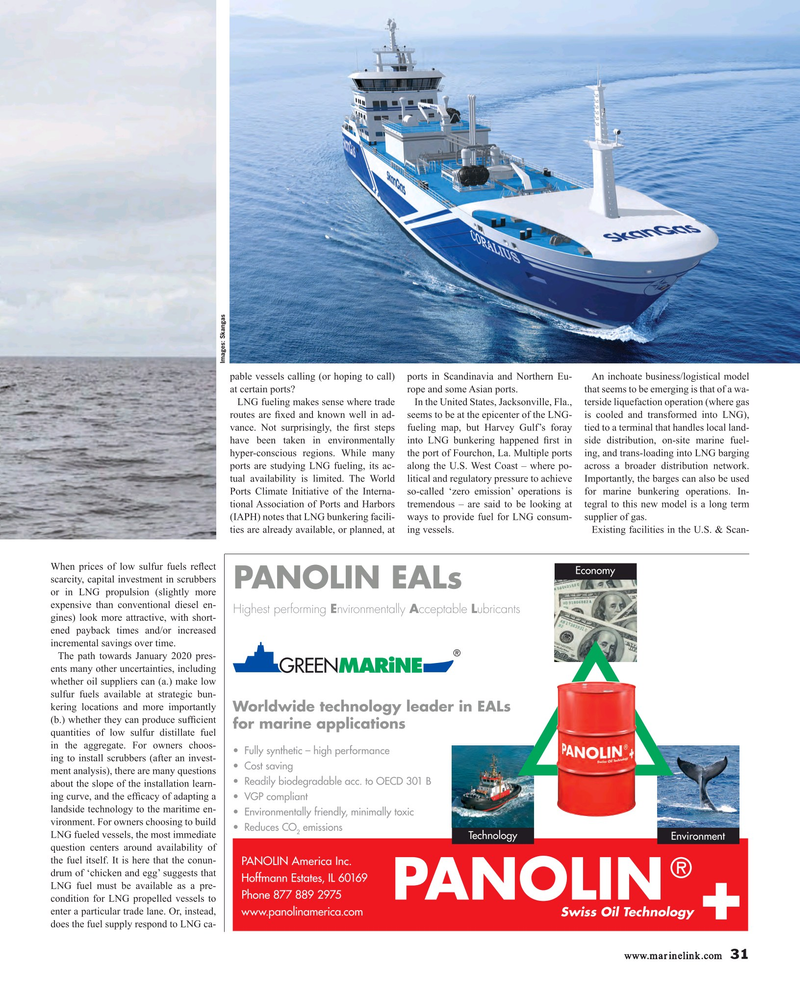
Page 31: of Maritime Reporter Magazine (May 2018)
Marine Propulsion Edition
Read this page in Pdf, Flash or Html5 edition of May 2018 Maritime Reporter Magazine
Images: Skangas pable vessels calling (or hoping to call) ports in Scandinavia and Northern Eu- An inchoate business/logistical model at certain ports? rope and some Asian ports. that seems to be emerging is that of a wa-
LNG fueling makes sense where trade In the United States, Jacksonville, Fla., terside liquefaction operation (where gas routes are ? xed and known well in ad- seems to be at the epicenter of the LNG- is cooled and transformed into LNG), vance. Not surprisingly, the ? rst steps fueling map, but Harvey Gulf’s foray tied to a terminal that handles local land- have been taken in environmentally into LNG bunkering happened ? rst in side distribution, on-site marine fuel- hyper-conscious regions. While many the port of Fourchon, La. Multiple ports ing, and trans-loading into LNG barging ports are studying LNG fueling, its ac- along the U.S. West Coast – where po- across a broader distribution network. tual availability is limited. The World litical and regulatory pressure to achieve Importantly, the barges can also be used
Ports Climate Initiative of the Interna- so-called ‘zero emission’ operations is for marine bunkering operations. In- tional Association of Ports and Harbors tremendous – are said to be looking at tegral to this new model is a long term (IAPH) notes that LNG bunkering facili- ways to provide fuel for LNG consum- supplier of gas. ties are already available, or planned, at ing vessels. Existing facilities in the U.S. & Scan-
When prices of low sulfur fuels re? ect scarcity, capital investment in scrubbers
PANOLIN EALs or in LNG propulsion (slightly more expensive than conventional diesel en-
Highest performing Environmentally Acceptable Lubricants gines) look more attractive, with short- ened payback times and/or increased incremental savings over time.
The path towards January 2020 pres- ents many other uncertainties, including whether oil suppliers can (a.) make low sulfur fuels available at strategic bun- kering locations and more importantly
Worldwide technology leader in EALs (b.) whether they can produce suf? cient for marine applications quantities of low sulfur distillate fuel in the aggregate. For owners choos- t'VMMZTZOUIFUJDoIJHIQFSGPSNBODF ing to install scrubbers (after an invest- t$PTUTBWJOH ment analysis), there are many questions t3FBEJMZCJPEFHSBEBCMFBDDUP0&$%# about the slope of the installation learn- ing curve, and the ef? cacy of adapting a t7(1DPNQMJBOU landside technology to the maritime en- t&OWJSPONFOUBMMZGSJFOEMZ
NJOJNBMMZUPYJD vironment. For owners choosing to build t3FEVDFT$0 emissions 2
LNG fueled vessels, the most immediate question centers around availability of the fuel itself. It is here that the conun-
PANOLIN America Inc.
drum of ‘chicken and egg’ suggests that
Hoffmann Estates, IL 60169
LNG fuel must be available as a pre-
Phone 877 889 2975 condition for LNG propelled vessels to enter a particular trade lane. Or, instead, www.panolinamerica.com does the fuel supply respond to LNG ca- www.marinelink.com 31
MR #5 (26-33).indd 31 MR #5 (26-33).indd 31 5/4/2018 3:14:57 PM5/4/2018 3:14:57 PM

 30
30

 32
32
